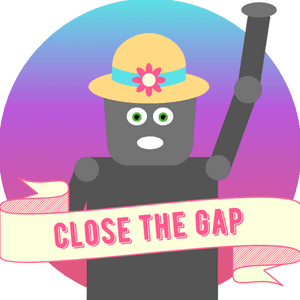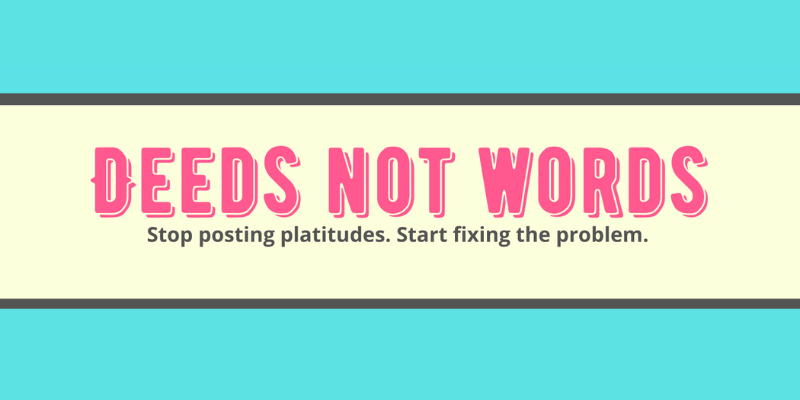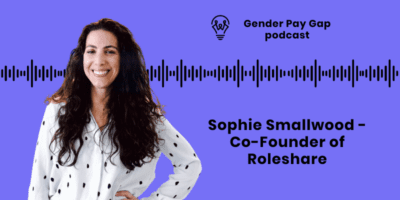Francesca Lawson is a freelance copywriter and social media manager, who is also one half of the duo that created @PayGapApp, a Twitter bot that uses publicly available gender pay gap data to nudge companies to stop posting platitudes and to start fixing their gender pay gaps. Francesca and her partner, Ali Fensome, hit upon the idea for the app during a COVID lockdown in 2021, and since then the Bot has amassed a global following of 248,000 and counting. Francesca and Ali are passionate about spreading the mantra that we all need to support gender equality through tangible actions 365 days a year, not just on International Women’s Day.

“For me, progress starts with focusing on facts and data rather than more sentimental statements like messages of empowerment and celebration.”
Time to try something different
I launched my freelance copywriting and social media business in November 2021 after two years of travel marketing in the middle of a pandemic. Fun, inspirational campaigns were pulled in favour of informative messages about COVID rules and travel advice, and as restrictions began lifting, I decided it was time for me to make a change too. At the point where I resigned, I thought: “If there’s any time to make a change and try something different, it’s now.”
We need more than corporate solidarity to reach gender parity
The Gender Pay Gap Bot is a completely automated Twitter account that retrieves gender pay gap data from the UK Government’s online database containing gender pay gap data for companies with more than 250 employees. There may be large companies ‘missing’, but this will be because they’re not UK-based.
So, whenever one of the companies on that list tweets about International Women’s Day or any topics to do with equality, diversity and inclusion the Bot will retrieve their most recent pay gap and publish it as a quote tweet so the data is there alongside their tweet, so anyone viewing it can make up their own mind as to whether what a company is saying in support of women is genuine and backed up by action, or whether it’s just empty words papering over the cracks around addressing the issues of gender inequality within their organisation.
With regards to the technology, there are three main parts to it. The first part is matching the companies to their Twitter account. That is done by a program we’ve built that searches Twitter using the company names as they appear in the Government’s data set.
The matching is all automated. There’s various different criteria that qualify it as a match, such as percentage accuracy, location, and number of followers.
My partner, Ali Fensome, built the code to track several keywords related to International Women’s Day, including the ‘embrace equity’ theme. The ‘themes’ come from a marketing website that promotes the commercialisation of IWD. The UN’s ‘official’ theme was around technology for a more equitable future.
Then we move on to the third part, which is publishing the pay gap data. When both of the two previous criteria have been met, i.e. when we’ve found a tweet with an International Women’s Day key phrase, and it’s come from one of the companies in the government’s gender pay gap website, we automatically retrieve and post their most recent pay gap.
Creating interest around pay transparency worldwide
This year we’ve published more tweets than last year — 1,792 tweets in 2023, which is slightly higher than last year’s figure of 1,755. It’s surprising in a way, as I’d thought that after we called out so many companies last year that the organisations maybe be a bit more cautious this year, but no! They still went for it in the same way…
We’ve had media coverage about the Bot from around the world. I find it really quite surreal that something that myself and my partner cooked up over a weekend in lockdown 2021 is now reaching people in Australia, Canada and the US as well!
I love how it’s helping to create more interest around pay transparency worldwide as well. I’ve had several people from different countries contact me saying: “I wish my government was doing something like the UK because I really want to see what my employer’s pay gap is.” or “I have a suspicion that my employer is not paying fairly.” So yeah, I think we’ve tapped into this sense of frustration that has been felt by more people than me around how employers communicate around gender equality and International Women’s Day.
It fires people up a bit and gives them a route to challenge the unequal behaviour they see. Companies can respond and reply too, so we’re initiating a conversation. It’s not just a tool to highlight the negative discrepancies between companies with what they say and what they do, it’s also a way of highlighting those organisations that are doing well.
Time to stop patronising women
For me, progress starts with focusing on facts and data rather than more sentimental statements like messages of empowerment and celebration. If you know you can back up your claims with some evidence, then that’s what the focus should be.
I’d like the media, society and businesses to stop patronising women. If you’re not sure whether what you’re saying is patronising or not then swap around genders. Would you say anything about ‘empowering and inspiring’ men? If you wouldn’t, then in all likelihood it’s going to come across as condescending. We need to treat women with respect. We need to treat them as the intelligent, engaged, savvy beings that they are, and not just people to put on a pedestal and admire.
Getting closer to a more equal society is not women’s responsibility. ‘Women supporting women’ doesn’t prevent biased hiring practices that always seem to put a man in charge. It’s not going to suddenly magic up more affordable childcare or better parental leave provisions. The things that make a difference rest with those in power, who are still predominantly male. We need more engagement from men allies to really make an impact. To overthrow patriarchal systems, we need to stand up, stick together, and make our voices heard, but we also need those in power to listen.
Also, if we want to make progress then we shouldn’t wait until there’s a trending event like International Women’s Day to invite women to speak, to listen to their voices, and to show that we care about gender equality. It’s got to be a year-round effort. If 8th March is the only time that you put a woman on a panel or a webinar then that’s just not good enough. You need to be putting women on all of your panels all year round!
In ‘All About Love,’ Bell Hooks wrote about how love is better seen as a verb, as an action, than a noun, and I think that the same is true with equity.
Keep on running

We have quite an important project coming up: with Twitter’s API changes in the pipeline, we need to adapt our technology to keep the Gender Pay Gap Bot running.
Other than that, I’m about to take a trip to visit a friend for the weekend, and I can’t wait. Last year I took on too much work after International Women’s Day and burned myself out, so this year I’ve carved out more time to rest, reflect, and re-energise myself to keep up the fight towards gender equality.





